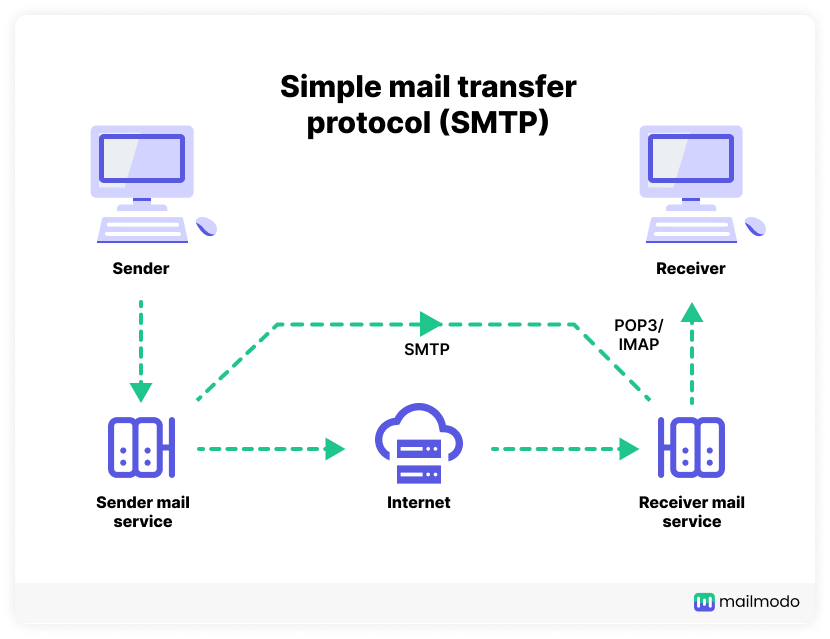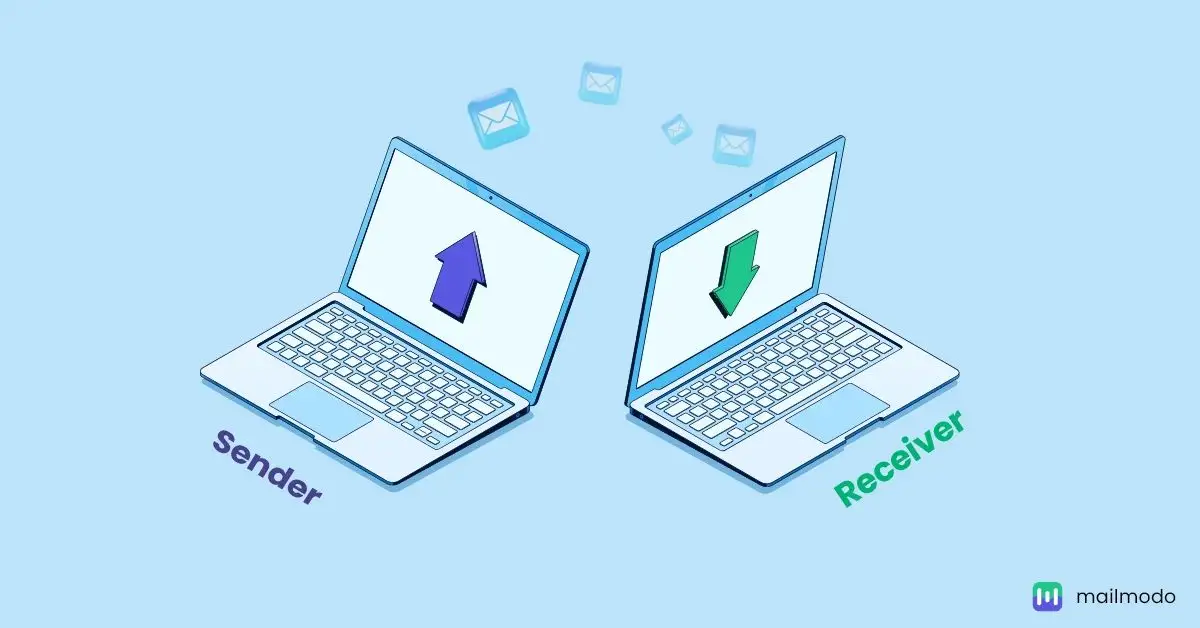SMTP or Simple Mail Transfer Protocol is a standard communication protocol for email delivery and transmission. Mail servers and other message transfer agents use SMTP service to send and receive emails. SMTPs affect email deliverability and thus email marketing conversions.
This guide will discuss SMTP, its types, working, and configurations.
Table of contents
- What is a protocol?
- What is SMTP?
- The importance of SMTP
- What are the components of SMTP?
- What are the types of SMTP?
- How does SMTP work?
- Popular SMTPs
- How are emails sent using SMTP?
- Conclusion
What is a protocol?
A protocol consists of a set of rules and procedures which govern the exchange of data between two or more devices. Protocols define how data transmission will precisely occur between electronic devices such as computers. They set the standard procedures for communication and the exchange of information.
The International Organization for Standardization established the Open Systems Interconnection (OSI). One such widely used Internet protocol lays down the standard for communication over different networks. The model divides the process of data transmission into a series of seven layers.
Important internet protocols are TCP/IP, HTTPS, DNS, and SMTP.
What is SMTP?
The Simple Mail Transfer Protocol is a communication protocol that allows the users on the same or different computers to send an email over the internet. It involves a particular set of guidelines according to which the communication via mail occurs.

The importance of SMTP
SMTP acts as a push protocol by transmitting the mail on and across the networks. It comes under the TCP/IP protocol application layer, where it works in a 'store' and 'forward' manner.
SMTP service facilitates mail exchange over networks. After recognizing the respective mail address, it sends the message to one or more recipients. The user can send the mail in various forms, such as text, video, or graphics.
What are the components of SMTP?
There are two primary components of the SMTP client and SMTP server. The first is User-Agent, and the second is a Mail Transfer Agent.
User-Agent (UA)
The User-Agent (UA) is responsible for preparing, creating, and putting the message in the form of an envelope for transmission.
Mail Transfer Agent (MTA)
The Mail Transfer Agent (MTA) then transfers this message to the 'recipient across the internet.
The SMTP servers support a more complex system by adding a relaying system in the process. Under this, more MTAs can be placed at either sending or receiving sides. In addition, this SMTP relay system can use mail gateways and work without TCP/IP protocols if needed.
What are the types of SMTP?
The different types of SMTP are:
1. End-to-end SMTP
In the SMTP model, the client-SMTP starts the communication session, whereas the SMTP at the receiver's side responds to the client's request. The end-to-end SMTP protocol helps send emails to servers at various other organizations. This model acts as a medium of communication between different organizations.
2. Store-and-forward SMTP
The store-and-forward SMTP model is different from the end-to-end SMTP model. The store-and-forward type is used within an organization only, unlike the end-to-end SMTP.
After contacting the destination's host directly, the SMTP server keeps the mail to itself until the receiver's SMTP successfully receives a copy of the email.
How does SMTP work?
The Transmission Control Protocol (TCP) is the primary connection for communication between the mail sender and the mail receiver. In SMTP, the mail sender sends the data in command strings over this reliable ordered data stream channel.
The SMTP client consisting of the initiating agent, sender, or transmitter initiates the communication session. It issues the command strings and opens the session for corresponding responses from the SMTP server, which involves the listening agent or receiver. Zero or more SMTP transactions may be there in a course.
Usually, an SMTP email transaction follows four command or reply sequences:
HELO/EHLO command
It tells the email server that the client wants to start the mail transaction. The client mentions its domain name after this command.
MAIL command
It lays down the bounce address/return address, defining the return or reverse paths.
RCPT command
It specifies the recipient of the message. The sender's envelope contains the addresses of the recipients, to which the RCPT command can be issued multiple times for each recipient.
DATA
It shows where the content of the message starts, as opposed to its envelope. An empty line separates the message header and body in the message's text. DATA is not just one command but a group of commands in which a server has to reply twice. First, the server acknowledges the message and replies with its readiness to take the message. Then after completing the end-of-data sequence, it either accepts or rejects the entire message.
Apart from the reply of the DATA command, the server can reply in a positive way (2xx reply codes) or a negative way. The negative responses can further be of two types; permanent (5xx codes) or transient (4xx codes).
If a server sends 'reject,' then it is a permanent failure, and the client needs to send a bounce message to the respective server. On the other side, a' drop' is a positive reply, in which the message is discarded instead of delivered.
Popular SMTPs
In 1982, one of the first MTAs to implement the Simple Mail Transfer Protocol, Sendmail with 4.1cBSD, was released. With time, it became a commonly used mail transfer agent.
Some other SMTP server programs that have become popular include Postfix, Qmail, Novell GroupWise, Exim, Novell NetMail, Microsoft Exchange Server, and Oracle Communications Messaging Server.
In 1998 and 1999, new trends in the delivery of emails set in along with the introduction of the Message submission (RFC 2476) and SMTP-AUTH (RFC 2554), respectively.
Some of the most popular SMTP servers include Amazon SES, Sendgrid, Mailgun, and others.
How are emails sent using SMTP?
The process of sending emails via SMTP port consists of the following sequential steps:
1. Composition
With the help of a Mail Transfer Agent (MUA) program, the user sends an email. The content of the email consists of two parts, email header and email body.
The header is the message's subject, while the body is the main content. The sender and recipient address also comes under the header part. The header acts like an envelope holding the letter (message).
2. Submission
The mail client (mail user agent, MUA) submits the email to a mail server (known as a mail submission agent, MSA) using SMTP on TCP port 587 or the traditional port 25. The MSA further delivers the mail to its mail transfer agent, MTA.
3. Mail delivery
The two parts of an email address are the recipient's username and the domain name. Let's take, for example, mayank@gmail.com, in which 'Mayank' is the username, and "gmail.com" is the domain.
In case the domain name of the recipient's email address does not match with the sender's domain name, then the mail submission agent (MSA) will send the mail to the (MTA).
Then, the MTA will search for the particular domain to relay the mail. First, it checks the MX record from the Domain Name System to obtain the target domain. The MX record contains recipients' domain names and IP addresses. Once it locates, MTA establishes the connection with the exchange server and relays the message.
4. Receipt and processing
After receiving the incoming message, the exchange server delivers it to the Mail Delivery Agent. Then, it stores the email and waits for the retrieval by the user.
5. Access and retrieval
The user can access the MUA with the login and password. In addition, the MUA helps retrieve the stored email from the MDA.
Conclusion
SMTPs are essential to send and receive emails. However, as an email marketer, you need to choose and configure the SMTP service providers that suit your requirements. At Mailmodo, we provide easy SMTP setup and integration with any SMTP servers you might like to send your email marketing campaigns. Feel free to reach out to the Mailmodo team to learn more.
What you should do next
Hey there, thanks for reading till the end. Here are 3 ways we can help you grow your business:
Talk to an email expert. Need someone to take your email marketing to the next level? Mailmodo’s experts are here for you. Schedule a 30-minute email consultation. Don’t worry, it’s on the house. Book a meet here.
Send emails that bring higher conversions. Mailmodo is an ESP that helps you to create and send app-like interactive emails with forms, carts, calendars, games, and other widgets for higher conversions. Sign up now and send 10k free emails/month. Sign up here.
Get smarter with our email resources. Explore all our knowledge base here and learn about email marketing, marketing strategies, best practices, growth hacks, case studies, templates, and more. Access guides here.


